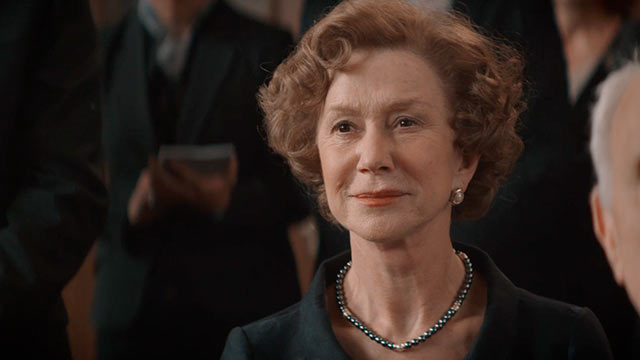‘Woman in Gold’: A compelling portrait of justice
“I want to keep the memories alive — People forget, you see.”
The latest film about Austrian-American Maria Altmann and her fight to regain her family's Klimt paintings stolen by the Nazis is “Woman in Gold.”
British super actress Helen Mirren portrays Maria and Ryan Reynolds portrays Randol Schoenberg, her young attorney with his own familial ties to Austria.
This film is engrossing from the outset, due to the subject matter presented by Alexi Kaye Campbell's well-written script and delivered by a gifted cast.
The flashback scenes Maria experiences throughout the decade she and Schoenberg spend battling the Austrian government for the return of the art, wrap around the mind and heart of the viewer.
Some memories, like her wedding day and moments with her Aunt Adele are happy ones; others, like the Nazis taking all of their family possessions of any monetary value — from silver candlesticks to Aunt Adele's gold and diamond choker to her father's prized Stradivarius cello, to the art are not so.
The most painful, grief stained memory: the day she and her husband, opera singer Frederick “Fritz” Altmann, left Vienna bound for the United States, leaving her parents behind. There are several scenes that will bring tears to your eyes, and this is one of them. The love, fear and sadness is palpable. And memorable. Just as her father's last words to her: “Remember us.”
The Altmanns end up living in Los Angeles, California. This incredible journey begins with the death of Maria's sister, and a letter she had in her possession written by the family's lawyer in 1948. The letter tells of the family's art stolen by the Nazis.
Maria, a friend of Randol's mother, inquires about him as a lawyer, saying she needs some advice. This case, which he refuses initially, ends up changing him forever. Randol comes to a greater understanding of the mental, physical and spiritual toll of the Holocaust on survivors and a greater awareness of his own family's history within that time frame. His grandfather was composer/pianist Arnold Schoenberg.
E. Randol Schoenberg went on to base the core of his legal practice in Los Angeles on art restitution cases — particularly those related to Nazi theft. He is the current president of the Los Angeles Museum of the Holocaust.
On their first visit to Vienna, a place Maria never planned to return to again, she and Randy “visit” her Aunt Adele at the Belvedere Gallery, where it, and the other family Klimt paintings have hung for 60 years. Mirren's reaction as Maria in seeing the painting is most moving — cue the tears.
Although they win the first battle, winning the right to sue the Austrian government the probability of “winning the war” becomes rather hopeless. According to Austrian law, a court filing fee equal to a percentage of the worth of the art in question, must be paid up front. In Maria's case, that amount was $1.5 million. The audience already knows at this point that Maria's only possessions are her small clothing business, modest bungalow and a small bit of money she has saved up for a new dishwasher.
Says Maria to Randy when she is ready to give up the fight, “They (the Austrian government) won't admit to one thing because then they would have to admit to it all.”
During his years of research, Randy discovers the Foreign Sovereign Immunities Act (FISA). But not until he sees an art book, produced by the Belvedere Museum with Aunt Adele Bloch-Bauer on the cover, does Maria's case meet all of the criteria for using the FISA to further the case.
Excitedly Randy comes to Maria, with the book in his hands pointing out that now the Austrian government was engaging in commercial activity outside of its borders, which changed its foreign immunity status.
Maria wants no part of it.
“The past is the past. They destroyed my family, they killed my friends, and they forced me to abandon the people and places I loved. I will not let them humiliate me further.”
In 2004, the U.S. Supreme Court upheld the validity of applying the (FISA) to a case prior to its enactment in 1976, with Maria Altmann's case.
It is not in a court setting, but in a meeting with an arbitration committee that Maria Altmann's family paintings are ordered returned to her.
Dame Mirren and Reynolds make for a wonderful “costar duo.”
At one point Maria says to Randy: “It's like we're in a James Bond movie and you're Sean Connery.”
Well, sometimes. Often its more like a grandmother and her grandson, case and point: Seated at a diner, Maria takes off Randy's glasses, spits on a lens and wipes if off asking how he can possibly see out of them.
In one scene, in which the Austrian-Jewish families are having their chance to “be heard,” by Austrian officials, Maria says, “People see a masterpiece by one of Austria's finest artists. But, I see my aunt. We should be reunited with what is rightfully ours.”
As the closing credits inform, there are still over 100,000 works of art somewhere that belong to the descendants of families like the Bloch-Bauers, Rothschilds, and so very many others.
Maria says: “Once the past has been put to right, we will not have come here for nothing.”
This film is a celebration and testimony of one case of the past being put to right. May there continue to be more.
Event Date
Address
185 Townsend Avenue
Boothbay Harbor, ME 04538
United States
























